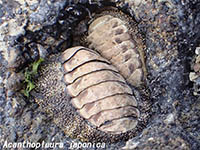日本語 / English
OWADA Masato's Home Page
— about my bird watching and molluscan research —
Chitons
The Chitons
It is estimated that there are over 100,000 living species of mollusks, and they are classified into eight classes. The three most well-known classes are Gastropoda, which includes snails; Bivalvia, which includes clams; and Cephalopoda, which includes squid. Chitons, however, belong to one of the lesser-known remaining five classes, the class Polyplacophora. Approximately 98% of molluscan species belong to either Gastropoda or Bivalvia, whereas only about 1,100 species of Polyplacophora have been identified worldwide, with 100 of those found in Japan.
Chitons possess a flattened and oval shape and eight shell valves on the dorsal side. These valves are surrounded by a tough tissue called "girdle" and are covered with scales or spines. Although they have a mouth, they lack a distinct head. They also possess specialized organs called aesthetes embedded within their valves, which function similarly to eyes. All chiton species are marine and live by clinging to substrates such as rock and algae. Inside their mouths, they have a radula, a file-like feeding organ similar to that found in gastropods, which they use to scrape algae and microorganisms from the substrate surface for feeding. A photograph of a chiton is shown below.
Chitons have one of the oldest fossil records among mollusks, dating back to the Late Cambrian (approximately 480 million years ago). However, fossils that can be reliably identified as chitons are not found until the Ordovician.

Classification of chitons
The classification of present chitons is based on several morphological and anatomical characteristics, including the shape of the valves and girdle, the arrangement of the gills, the form of the radula, the morphology of sperm and eggs, and features of the shell microstructure. Based on these characteristics, chitons have been grouped into 9 to 19 families. These families are further categorized into 2 to 4 higher taxa such as orders or suborders, all of which are placed within the subclass or order Neoloricata.
Recently, phylogenetic analyses based on DNA sequences have become inexpensive and accessible. Studies applying these methods have supported a classification in which all present chitons are placed within the subclass Neoloricata, which is further divided into two orders: Lepidopleurida and Chitonida. These two orders are primarily distinguished by the development of the insertion plates and sutural laminae. In Lepidopleurida, both of these structures are poorly developed. The sutural laminae are fan-shaped shell structures that project forward from both lateral sides of each valve, while the insertion plates are short tooth-like shell structures that extend downward from the margins of the valves. Both structures are embedded within the girdle and serve to connect the valves to the girdle.
Members of the order Lepidopleurida can be classified relatively easily because of the poor development of sutural laminae and insertion plates. However, the order Chitonida contains a wide variety of species and is therefore subdivided into two suborders: Chitonina and Acanthochitonina. These suborders are distinguished by the arrangement of the gills, egg morphology, and features of the shell microstructure, and phylogenetic analyses based on DNA sequences also support this classification. Shell microstructure refers to the fine-scale internal structure of the valves. Its characteristics are examined by fracturing the valve and observing the cross-section with a scanning electron microscope.
Although the current classification of chitons appears to be relatively stable, a complete and universally accepted classification has not yet been established. For example, in the family Callochitonidae, the morphological characteristics and the results of phylogenetic analyses based on DNA sequences are incongruent, making its taxonomic position unresolved. Some researchers have proposed that it be placed in a third order, Callochitonida. The composition of superfamilies and families also remains unresolved, as different researchers prioritize different morphological characteristics. An example of a classification for chitons collected in Japan is shown below.
| class 綱 |
subclass 亜綱 |
order 目 |
suborder 亜目 |
superfamily 超科 |
family 科 |
| Polyplacophora 多板綱 |
Neoloricata 新ヒザラガイ亜綱 |
Lepidopleurida サメハダヒザラガイ目 |
Ferreiraellidae ヒラタヒザラガイ科 | ||
| Leptochitonidae サメハダヒザラガイ科 | |||||
| Nierstraszellidae フカヅメヒザラガイ科 | |||||
| Protochitonidae カギヅメヒザラガイ科 | |||||
| Chitonida クサズリガイ目 |
Chitonina クサズリガイ亜目 |
Chitonoidea クサズリガイ超科 |
Callochitonidae ハチノスヒザラガイ科 | ||
| Ischnochitonidae ウスヒザラガイ科 | |||||
| Callistoplacidae カブトヒザラガイ科 | |||||
| Loricidae ヨロイヒザラガイ科 | |||||
| Chitonidae クサズリガイ科 | |||||
| Acanthochitonina ケハダヒザラガイ亜目 |
Mopalioidea ヒゲヒザラガイ超科 |
Tonicellidae マダラヒザラガイ科 | |||
| Schizoplacidae セワケヒザラガイ科 | |||||
| Mopaliidae ヒゲヒザラガイ科 | |||||
| Cryptoplacoidea ケムシヒザラガイ超科 |
Acanthochitonidae ケハダヒザラガイ科 | ||||
| Cryptoplacidae ケムシヒザラガイ科 |